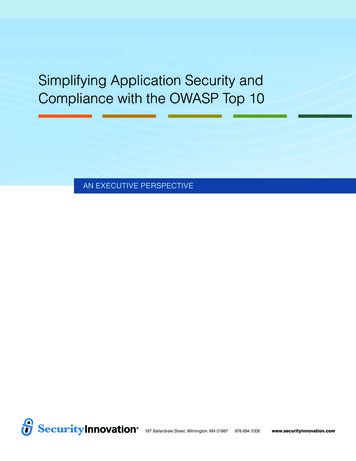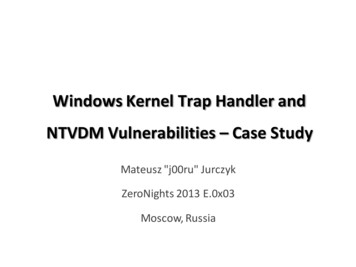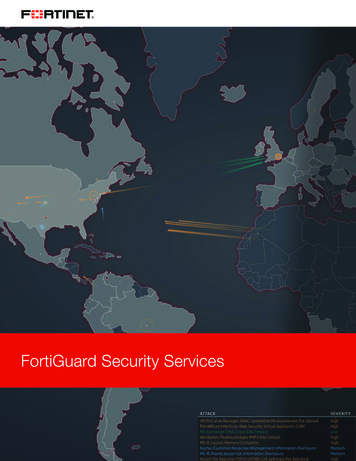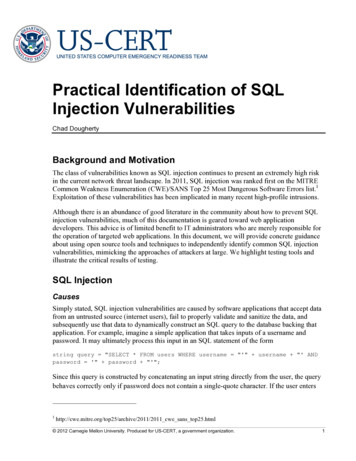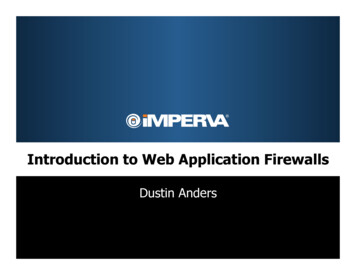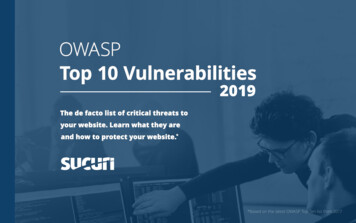
Transcription
OWASPTop 10 Vulnerabilities2019The de facto list of critical threats toyour website. Learn what they areand how to protect your website.**Based on the latest OWASP Top Ten list from 2017
2The Top 10 OWASP vulnerabilities areOWASP stands for the Open Web Application1. Injection3Security Project, that produces articles,2. Broken Authentication4methodologies, documentation, tools, and technologies3. Sensitive data exposure54. XML External Entities (XXE)85. Broken Access control9in the field of web application security.OWASP Core Purpose: Be the thriving globalcommunity that drives visibility and evolution inthe safety and security of the world’s software. 2019 Sucuri. All Rights Reserved.6. Security misconfigurations117. Cross-Site Scripting (XSS)138. Insecure Deserialization159. Using Components with Known Vulnerabilities1610. Insufficient Logging and Monitoring17This ebook, “OWASP Top Ten Vulnerabilities 2019”, cites information and examples found in “Top 10-2017 Top Ten” by OWASP, used under CC BY-SA.
1. InjectionAn injection of code happens when an attacker sends invalid data to the web applicationHere is another example of an SQL injection that affected over half a million websites.with the intention to make it do something different from what the application wasThis code is part of the function get products(). If attackers set arbitrary values for thedesigned/programmed to do.variable limit they can modify the query in a way that can lead to a full compromise onPerhaps the most common example around this security vulnerability is the SQL querysome servers.consuming untrusted data. You can see one of OWASP’s examples below:String query “SELECT * FROM accounts WHEREcustID ‘” request.getParameter(“id”)If ( ! empty( is default ) ) { “’”;if( ! empty( user id) ) { this- generate defualt wishlist( user iD );}This query can be exploited by calling up the web page executing it with the following URL: sql. “ AND l. is default %d”;http://example.com/app/accountView?id ’ or ’1’ ’1, causing the return of all the rowsstored on the database table.}if (! empty( id ) ) {The core of a code injection vulnerability is the lack of validation and sanitization of the sql. “ AND i.ID %d”;data consumed by the web application, which means that this vulnerability can be present sql args [] id;on almost any type of technology.}Anything that accepts parameters as sql . “GROUP BY i.prod id, L.ID”;if (!empty ( limit ) && isset ( offset ) ) { sql . “ LIMIT “. offset . “ , “. limit;}input can potentially be vulnerableto a code injection attack. wishlist wpdb- get results ( wpdb prepare ( sql, sql args ), ARRAY A );}3
42. Broken AuthenticationA broken authentication vulnerability can allow an attackerto use manual or automatic mediums to try to gaincontrol over a user account – or even worse – to gaincomplete control over the tiesare very common on the web. Broken Authenticationusually refers to logic issues that occur on the applicationauthentication’s mechanism, like bad session managementprone to username enumeration.To avoid broken authentication, don’t leave the login pagefor admins publicly accessible to all visitors of the website:Types of VulnerabilitiesHowever, broken authentication vulnerabilities can comein many forms. According to OWASP, a web applicationIn order to avoid broken authentication vulnerabilities,contains a broken authentication vulnerability if it:make sure the developers apply best practices to website Permits automated attacks such as credentialstuffing, where the attacker has a list of validusernames and passwords. Permits brute force or other automated attacks. Permits default, weak, or well-known passwords,such as”Password1″ or “admin/admin“. Uses weak or ineffective credential recovery andforgot-password processes, such as “knowledge-/administrator on Joomla!,/wp-admin/ on WordPress,/index.php/admin on Magento,/user/login on Drupal.based answers”, which cannot be made safe. Uses plain text, encrypted, or weakly hashedpasswords. Has missing or ineffective multi-factor authentication. Exposes Session IDs in the URL (e.g., URL rewriting).The second most common form of this flaw is allowingusers to brute force username/password combinationsagainst those pages.How do you prevent broken authenticationvulnerabilities? Does not rotate Session IDs after successful login. Does not properly invalidate Session IDs. Usersessions or authentication tokens (particularlysingle sign-on (SSO) tokens) aren’t properlyinvalidated during logout or a period of inactivity.security. Provide access to external security audits andenough time to properly test the code before deployingto production.OWASP’s technical recommendations are the following: Align password length, complexity, and rotationpolicies with NIST 800-63 B’s guidelines in section5.1.1 for Memorized Secrets or other modern,evidence-based password policies. Ensure registration, credential recovery, andAPI pathways are hardened against accountenumeration attacks by using the same messagesfor all outcomes. Limit failed login attempts. Log all failures and alertadministrators when credential stuffing, bruteforce, or other attacks are detected. Use a server-side, secure, built-in session managerthat generates a new, random session ID with highentropy after login. Session IDs should not be inWriting insecure software results in most of thethe URL. ID’s should also be securely stored andtypes of broken authentication vulnerabilities. They caninvalidated after logout, idle, and absolute timeouts.be attributed to many factors, like lack of experiencefrom the developers or institutionalized failures suchas organizations rushing software releases—in otherwords, choosing working software over secure software.
53. Sensitive Data ExposureSensitive data exposure is one of the most widespread vulnerabilities. It consists of stolen PII(personally identifiable information) data that should have been protected. These are commonlyknown as data breaches.What Are the Risks?According to OWASP, here are a few examples of what canhappen when sensitive data is exposed:Scenario #1: An application encrypts credit cardExamples of Sensitive DataProtecting Data in TransitSome sensitive data that requires protection is:Both types of data should be protected. When thinking Passwords Credit card numbersabout data in transit, one way to protect it on a website isby having an SSL certificate.numbers in a database using automatic databaseencryption. However, this data is automaticallydecrypted when retrieved, allowing an SQL injectionflaw to retrieve credit card numbers in clear text. CredentialsSSL is the common (but deprecated) name for the TLSScenario #2: A site doesn’t use or enforce TLS for Social Security Numbersprotocol, used to establish an encrypted link between aall pages or supports weak encryption. An attacker Health informationweb server and a browser.monitors network traffic (e.g. at an insecure wireless Personally Identifiable Information Other personal informationIt is vital for any organization to understand the importanceof protecting users’ information and privacy. All companiesshould comply with their local privacy laws.Responsible sensitive data collection and handling haveWe have created a DIY guide to help every website ownerinstall an SSL certificate to their website. You can checkout How to Install an SSL Certificate.network), downgrades connections from HTTPSto HTTP, intercepts requests, and steals the user’ssession cookie. The attacker then replays this cookieand hijacks the user’s (authenticated) session,accessing or modifying the user’s private data.Instead of the above they could alter all transporteddata, e.g. the recipient of a money transfer.become more noticeable, especially after the advent ofthe General Data Protection Regulation (GDPR). GDPR isScenario #3: The password database uses unsalteda new landmark data privacy law that came into effect Mayor simple hashes to store everyone’s passwords. A2018. Ecommerce websites can reference the PCI DSSfile upload flaw allows an attacker to retrieve therequirements to secure cardholder data.password database. All the unsalted hashes canbe exposed with a rainbow table of pre-calculatedhashes. Hashes generated by simple or fast hashfunctions may be cracked by GPUs, even if they weresalted.
6Why is Sensitive Data Exposure so Common?Over the last few years, sensitive data exposure has been one of the most common attacks around the world.Some examples of data leaks that resulted in sensitive data exposure are: The Brazilian C&A, a fashion retail clothing chain suffered a gift card platform cyberattack in August2018.THE AVERAGE DATA EXPOSURE COSTS AN SMB The Uber breach in 2016 that exposed the personal information of 57 million Uber users, as well as600,000 drivers.85,000 USD The Target store data breach that occurred around Thanksgiving exposing credit/debit card andcontact information of up to 110 million people.Failure to encrypt sensitive data is the main reason why these attacks are still so widespread. Even encrypteddata can be broken due to the following weaknesses: Key generation process; Key management process; Algorithm usage; Protocol usage; Cipher usage;This vulnerability is usually very hard to explore; however, the consequences of a successful attack is dreadful.If you want to learn more, we have written a blog post on the Impacts of the Security Breach.THE AVERAGE COST FOR ENTERPRISE5 Million USD
7How to Prevent Data ExposureHere are some of the ways to prevent data exposure, according to OWASP: Classify data processed, stored, or transmitted by an application. Identify which data is sensitive according to privacy laws, regulatory requirements, or business needs. Apply controls, as per the classification. Don’t store sensitive data unnecessarily. Discard it as soon as possible or use PCI DSS compliant tokenization or even truncation. Data that is not retainedcannot be stolen. Make sure to encrypt all sensitive data at rest. Ensure up-to-date and strong, standard algorithms, protocols, and keys are in place; use proper key management. Encrypt all data in transit with secure protocols such as TLS with perfect forward secrecy (PFS) ciphers, cipherprioritization by the server, and secure parameters. Enforce encryption using directives like HTTP Strict Transport Security (HSTS). Disable caching for responses that contain sensitive data. Store passwords using strong adaptive and salted hashing functions with a work factor (delay factor), such as Argon2,scrypt, bcrypt, or PBKDF2. Verify independently the effectiveness of configuration and settings.
84. XML External Entities (XXE)How to Prevent XML External Entity AttacksAccording to WikipediaAn XML External Entity attack is a type of attack against an application that parses XML input. This attack occurs whenXML input containing a reference to an external entity is processed by a weakly configured XML parser.Most XML parsers are vulnerable to XXE attacks by default, and an XXE can occur in deeply nested dependencies. That is why theresponsibility of ensuring the application does not have this vulnerability lies mostly on the developerSome of the ways to prevent XML External Entity attacks,according to OWASP are: Whenever possible, use less complex data formatssuch as JSON, and avoid serialization of sensitivedata. Patch or upgrade all XML processors and libraries inuse by the application or on the underlying operatingWhat Are the Attack Vectors?Example of an XML External Entity AttackAccording to OWASP, the XML external entities (XXE) mainAccording to OWASP, the easiest way to exploit an XXE is isattack vectors are:to upload a malicious XML file. ExploitationofvulnerableXMLprocessorsifmalicious actors can upload XML or include hostilecontent in an XML document; Exploitation of vulnerable code; Exploitation of vulnerable dependencies; Exploitation of vulnerable integrations.Scenario #1: The attacker attempts to extract data fromthe server:system. Use dependency checkers (update SOAP to SOAP1.2 or higher). Disable XML external entity and DTD processing inall XML parsers in the application, as per the OWASPCheat Sheet ‘XXE Prevention’. Implement positive (“whitelisting”) server-side input ?xml version ”1.0” encoding ”ISO-8859-1”? validation, filtering, or sanitization to prevent hostile !DOCTYPE foo [data within XML documents, headers, or nodes. !ELEMENT foo ANY Verify that XML or XSL file upload functionality !ENTITY xxe SYSTEM “file:///etc/passwd” ] validates incoming XML using XSD validation or foo &xxe; /foo similar. SAST tools can help detect XXE in source code –Scenario #2: An attacker probes the server’s privatenetwork by changing the above ENTITY line to: !ENTITY xxe SYSTEM “https://192.168.1.1/private” ] although manual code review is the best alternativein large, complex applications with many integrations.If these controls are not possible, consider using virtualpatching, API security gateways, and a Web ApplicationFirewalls (WAFs) to detect, monitor, and block XXE attacks.Scenario #3: An attacker attempts a denial-of-serviceattack by including a potentially endless file: !ENTITY xxe SYSTEM “file:///dev/random” ]
5. Broken Access ControlIn website security, access control means to put a limit on what sections orpages visitors can reach, depending on their needs.Examples of Access Access to a hosting control / administrative panelFor example, if you own an ecommerce store, you probably need access to the Access to a server via FTP / SFTP / SSHadmin panel in order to add new products or to set up a promotion for the Access to a website’s administrative panelupcoming holidays. However, hardly anybody else would need it. Having the Access to other applications on your serverrest of your website’s visitors be able to reach your login page only opens up Access to a databaseyour ecommerce store to attacks.And that’s the problem with almost all major content management systemsThese are ways attackers can exploit authorization flaws:(CMSs) these days. By default, they give worldwide access to the admin panel. Access unauthorized functionality and/or data;Most of them also won’t force you to establish a second-factor authentication View sensitive files;method (2FA). Modify other users’ data;The above makes you look at software development with a security-first Change access rights, etc.philosophy. Access control issues are also present in other areas.9
10Broken Access ControlWhat Are the Risks?Reducing the Risks of Broken Access ControlHow to Prevent Broken Access ControlAccording to OWASP, here are a few examples of what can happen when there isThere are things you can do to reduce the risk of broken access control:With the exception of public resources, deny by default.broken access control:1. Employ least privileged concepts – apply a role appropriate to the taskScenario #1: The application uses unverified data in a SQL call that is2. Remove accounts you don’t need.accessing account (“acct”));and no more.ResultSetresults pstmt.executeQuery( );An attacker simply modifies the ‘acct’ parameter in the browser to sendwhatever account number they want. If not properly verified, the attacker canaccess any user’s account.http://example.com/app/accountInfo?acct notmyacctScenario #2: An attacker simply force browses to target URLs. Admin rightsare required for access to the admin le.com/app/admin getappInfo3. Audit your servers and websites – who is doing what, when, and why.4. If possible, apply multi-factor authentication to all your access points.5. Disable access points until needed in order to reduce your access windows.Implement access control mechanisms once and reuse them throughout theapplication, including minimizing CORS usage.The technical recommendations by OWASP to prevent broken accesscontrol are: Model access controls should enforce record ownership, rather than6. Remove unnecessary services off your server.accepting that the user can create, read, update, or delete any record.7. Verify applications that are externally accessible versus applications thatNote: For example, if a user log-ins as “John”, he could only create, read,are tied to your network.8. If you are developing a website, bear in mind that a production box shouldnot be the place to develop, test, or push updates without testing.update or delete records associated with the id of “John”. Never the datafrom other users. Unique application business limit requirements should be enforced bydomain models. Disable web server directory listing and ensure file metadata (e.g. .git) andbackup files are not present within web roots. Log access control failures, alert admins when appropriate (e.g. repeatedfailures). Note: We recommend our free plugin for WordPress websites,that you can download directly from the official WordPress repository.Developers are going to be more familiar with the above scenarios, butremember that broken access control vulnerabilities can be expressed in many Rate limit API and controller access to minimize the harm from automatedattack tooling.forms through almost every web technology out there; it all depends on what JWT tokens should be invalidated on the server after logout.you use on your website. Developers and QA staff should include functional access control unit andintegration tests.
116. Security MisconfigurationsHackers are always looking for ways to penetrate websites, andsecurity misconfigurations can be an easy way in. Here are someexamples of things that hackers usually try to exploit in order togain unauthorized access: Unpatched flaws Default configurations Unused pages Unprotected files and directories Unnecessary servicesWhere Can Security Misconfiguration Happen?Security misconfiguration can happen at any level of anapplication stack, including: Network services, Platform, Web server, Application server, Database, Frameworks,One of the most common webmaster flaws is to keep the CMS Custom code,default configurations. Pre-installed virtual machines,Today’s CMS applications (although easy to use) can be trickyfrom a security perspective for the end users. By far the most Containers, Storage.common attacks are entirely automated. Many of these attacksOne example of application misconfigurations is the memcachedrely on users having only default settings.servers which, left on default settings, have an open UDP portThis means that a large number of attacks can be avoided bychanging the default settings when installing a CMS.For example, some CMS applications are writeable by the user –allowing a user to install whatever extensions they want.There are settings you may want to adjust to control comments,users, and the visibility of user information. The file permissionsare another example of a default setting that can be hardened.that attackers used to DDoS huge services in the tech industry. .
12Security MisconfigurationsScenario #1: The application server comes with sample applications thatare not removed from the production server.These sample applications have known security flaws attackers use tocompromise the server. If one of these applications is the admin consoleand default accounts weren’t changed, the attacker logs in with defaultpasswords and takes over.How to Have Secure Installation SystemsAccording to OWASP, here are some examples of security misconfigurations. A repeatable hardening process that makes it fast and easy to deployanother environment that is properly locked down. Development, QA, and production environments should all be configuredidentically, with different credentials used in each environment. AutomateScenario #2: Directory listing is not disabled on the server. An attackerthis process in order to minimize the effort required to set up a newdiscovers they can simply list directories. They find and download thesecure environment.compiled Java classes, which they decompile and reverse engineer to A minimal platform without any unnecessary features, components,view the code. The attacker then finds a serious access control flaw in thedocumentation, and samples. Remove or do not install unused featuresapplication.and frameworks. A task to review and update the configurations appropriate to all securityScenario #3: The application server’s configuration allows detailednotes, updates, and patches as part of the patch management process. Inerror messages, e.g. stack traces, to be returned to users. This potentiallyparticular, review cloud storage permissions.exposes sensitive information or underlying flaws, such as componentversions. They are known to be vulnerable. A segmented application architecture that provides effective andsecure separation between components or tenants, with segmentation,containerization, or cloud security groups.Scenario #4: A cloud service provider has default sharing permissions Sending security directives to clients, e.g. Security Headers.open to the Internet by other CSP users. This allows stored sensitive data An automated process to verify the effectiveness of the configurationsto be accessed within cloud storage.and settings in all environments.
137. Cross-Site Scripting (XSS)Cross Site Scripting (XSS) is a widespread vulnerability that affects many webapplications. XSS attacks consist of injecting malicious client-side scripts into awebsite and using the website as a propagation method.The danger behind XSS is that it allows an attacker to inject content into awebsite and modify how it is displayed, forcing a victim’s browser to executethe code provided by the attacker while loading the page.XSS is present in about two-thirds of all applications.Generally, XSS vulnerabilities require some type of interaction by the user to betriggered, either via social engineering or via a visit to a specific page. If an XSSvulnerability is not patched, it can be very dangerous to any website.Examples of XSS VulnerabilitiesImagine you are on your WordPress wp-admin panel adding a new post. If youare using a plugin with a stored XSS vulnerability that is exploited by a hacker, itcan force the browser to create a new admin user while in the wp-admin panelor it can edit a post and perform other similar actions.An XSS vulnerability gives the attacker almost full control of the most importantsoftware of computers nowadays: the browsers.Last year, our research team disclosed a stored XSS vulnerability in thecore of WordPress websites. Remote attackers could use this vulnerabilityto deface a random post on a WordPress site and store malicious JavaScriptcode in it.
14Cross-Site Scripting (XSS)Scenario #1: The application server comes with sample applications that arenot removed from the production server. These sample applications have knownsecurity flaws attackers use to compromise the server. If one of these applications isTypes of XSSReflected XSSAccording to OWASP, there are three types of XSS:OWASP defines the following attack scenarios involving XSS vulnerabilities.1. The application or API includes unvalidated and unescaped user input asthe admin console and default accounts weren’t changed, the attacker logs in withdefault passwords and takes over.Scenario #2: Directory listing is not disabled on the server. An attacker discoversthey can simply list directories. They find and download the compiled Java classes,which they decompile and reverse engineer to view the code. The attacker then findsa serious access control flaw in the application.XSS TypeServerClientStoredStored ServerStored ClientReflectedReflected ServerReflected ClientDOM-Basedpart of HTML output. A successful attack can allow the attacker to executearbitrary HTML and JavaScript in the victim’s browser.2. Typically the user will need to interact with some malicious link that pointsto an attacker-controlled page, such as malicious watering hole websites,advertisements, or similar.Subset of ClientStored XSSScenario #3: The application server’s configuration allows detailed error messages,e.g. stack traces, to be returned to users. This potentially exposes sensitive informationor underlying flaws, such as component versions. They are known to be vulnerable.1. The application or API stores unsanitized user input that isviewed at a later time by another user or an administrator.Stored XSS is often considered high or critical risk.Scenario #4: A cloud service provider has default sharing permissions open to theInternet by other CSP users. This allows stored sensitive data to be accessed withincloud storage.DOM XSS1. JavaScript frameworks, single-page applications, and APIs thatdynamically include attacker-controllable data to a page arevulnerable to DOM XSS. Ideally, the application would not sendattacker-controllable data to unsafe JavaScript APIs.2. Typical XSS attacks include session stealing, account takeover,MFA bypass, DOM-node replacement or defacement (such asTrojan login panels), attacks against the user’s browser suchas malicious software downloads, keylogging, and other clientside attacks.
158. Insecure DeserializationIn computer science, an object is a data structure; in otherScenario #2: A PHP forum uses PHP object serializationwords, a way to structure data. s Two key concepts make itto save a “super” cookie, containing the user’s user ID, role,easier to understand:password hash, and other state: The process of serialization is converting objects to bytestrings. The process of deserialization is converting byte stringsto :4:”user”;According to OWASP, here are some examples of ”;}admin 5:”admin”;scenarios:Scenario #1: A React application calls a set of Spring BootThe best way to protect your web application from this type of risk is not toaccept serialized objects from untrusted sources.If you can’t do this, OWASP provides more technical recommendations thatyou (or your developers) can try to implement:An attacker changes the serialized object to give themselvesExample of Attack ScenariosHow to Prevent Insecure f3c88bc960”;} Implementing integrity checks such as digital signatures on anyserialized objects to prevent hostile object creation or data tampering. Enforcing strict type constraints during deserialization before objectcreation as the code typically expects a definable set of classes. Bypasses to this technique have been demonstrated, so reliancesolely on this is not advisable. Isolating and running code that deserializes in low privilegeenvironments when possible. Logging deserialization exceptions and failures, such as where themicroservices. Being functional programmers, they tried toensure that their code is immutable. The solution they cameOne of the attack vectors presented by OWASP regardingincoming type is not the expected type, or the deserialization throwsup with is serializing user state and passing it back and forththis security risk was a super cookie containing serializedexceptions.with each request. An attacker notices the “R00” Java objectinformation about the logged in user. The role of the user wassignature, and uses the Java Serial Killer tool to gain remotespecified in this cookie.code execution on the application server.If an attacker is able to deserialize an object successfully, thenmodify the object to give himself an admin role, they can serializeit again. This set of actions could compromise the whole webapplication. Restricting or monitoring incoming and outgoing network connectivityfrom containers or servers that deserialize. Monitoring deserialization, alerting if a user deserializes constantly.
169. Using Components with Known VulnerabilitiesThese days, even simple websites such as personal blogs have aWhatever the reason for running out-of-date software on yourlot of dependencies.web application is, you can’t leave it unprotected. Both SucuriWe can all agree that failing to update every piece of softwareon the backend and frontend of a website will, without a doubt,introduce heavy security risks sooner rather than later.For example, our hacked website report for 2018 has adedicated section around outdated CMSs. This report showsthat at the time of the infection: 36.7% of infected WordPress websites were out of date. 50% of infected Modx websites were out of date.and OWASP recommend virtual patching for the cases wherepatching is not possible.Virtual patching affords websites that are outdated (or withknown vulnerabilities) to be protected from attacks by preventingthe exploitation of these vulnerabilities on the fly. This is usuallydone by a firewall and an intrusion detection system.Vulnerable ApplicationsVulnerable applications are usually outdated, according to 72.6% of infected phpBB websites were out of date.OWASP if: 87.5% of infected Joomla! websites were out of date. 91.3% of infected OpenCart websites were out of date. 97.2% of infected PrestaShop websites were out of date.dependencies.This might be a little too dramatic, but every time you disregardan update warning, you might be allowing a now knownvulnerability to survive in your system. Cybercriminals are quickto investigate software and update changelogs. Monitor sources like Common Vulnerabilities and Disclosures(CVE) and National Vulnerability Database (NVD) for vulnerabilities Obtain components only from official sources. Get rid of components not actively maintained. Use virtual patching. The software is vulnerable, unsupported, or out of date.management system (DBMS), applications, APIs and all Legacy code won
OWASP Core Purpose: Be the thriving global community that drives visibility and evolution in the safety and security of the world's software. This ebook, "OWASP Top Ten Vulnerabilities 2019", cites information and examples found in "Top 10-2017 Top Ten" by OWASP, used under CC BY-SA.




